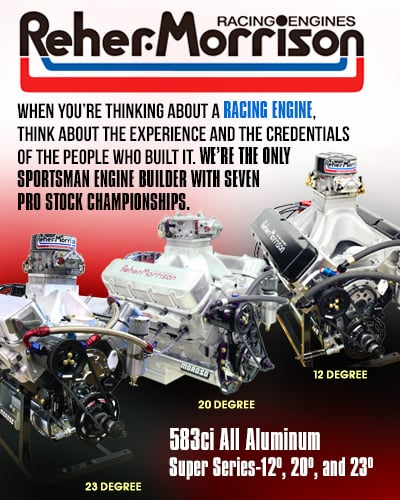MODERN DAY NOSTALGIA TAKING STOCK AND SS BY STORM
 This just might be the trend Detroit has needed for the last two decades.
This just might be the trend Detroit has needed for the last two decades.
“Race on Sunday, Sell on Monday” was the sales pitch made famous by the late auto dealer extraordinaire Bob Tasca during the 1960s creating a marketing tie with motorsports when drag racing led the way and NASCAR followed.
Tasca and dealers throughout the United States were selling factory-built packages capable of rolling off the Detroit assembly lines and right onto the drag strip with a classification and horsepower rating waiting on them.
Tasca certainly would have been proud with what has transpired at the most recent events on the NHRA tour.

This just might be the trend Detroit has needed for the last two decades.  “Race on Sunday, Sell on Monday” was the sales pitch made famous by the late auto dealer extraordinaire Bob Tasca during the 1960s creating a marketing tie with motorsports when drag racing led the way and NASCAR followed.
“Race on Sunday, Sell on Monday” was the sales pitch made famous by the late auto dealer extraordinaire Bob Tasca during the 1960s creating a marketing tie with motorsports when drag racing led the way and NASCAR followed.
Tasca and dealers throughout the United States were selling factory-built packages capable of rolling off the Detroit assembly lines and right onto the drag strip with a classification and horsepower rating waiting on them.
Tasca certainly would have been proud with what has transpired at the most recent events on the NHRA tour.
At the recently completed NHRA O’Reilly Auto Parts Nationals at zMax Dragway in Concord, NC, the No. 1 qualifiers in both the Super Stock and Stock divisions were driving factory built race cars which were introduced to the public last season.
Roy Hill, driving NASCAR team owner James Finch’s 2010 Cobra Jet Mustang, was the No. 1 qualifier in Super Stock at the Concord race. Roy Johnson, a past sportsman standout who retired from active drag racing to build Pro Stock engines for his son Allen, paced the Stock eliminator division with his special edition 2009 Dodge Challenger.
Over the Labor Day weekend at the NHRA U.S. Nationals in Indianapolis, forty percent of the top twenty qualifiers in the NHRA’s Super Stock and Stock divisions were comprised of either these Mustangs or Challengers. In the Stock division, half of the top twenty qualifiers were in the purpose built street legals cars.
Consider this as one way Detroit is reinventing itself.
“It’s something new,” admitted Irvin Johns, who qualified No. 2 in Stock eliminator at Indy with a 2010 Drag Pak Challenger running in D/Stock Automatic.
“It’s just like going back to the old days with a limited production race car. I think the race fans really enjoy seeing these cars out here. A person can buy one at their local dealership. There were only 150 of these made.”
Just like drag racing in the 1960s, every car combination has a classification.
“I think a lot of people can relate to what they buy at the dealerships today,” said Hill, a retired Pro Stock racer and drag racing school instructor. “When the General Motors people get their cars out – which I know they are being developed – I think you are going to see things go back to just like they were in the '60s and '70s.” While Hill was around to race these kinds of cars in the 1960s, car collector Brent Hajek ensured he was around when the new cars began rolling off the assembly line. Hajek bought the first ten of a 50-car Cobra Jet production run last year.
While Hill was around to race these kinds of cars in the 1960s, car collector Brent Hajek ensured he was around when the new cars began rolling off the assembly line. Hajek bought the first ten of a 50-car Cobra Jet production run last year.
“I don’t know that there’s an advantage to these cars right now,” said Hajek. “I think the big lure is they are something new and different. I know there are those who think these cars are under-factored [in the horsepower ratings, determining index] but it’s awful hard for these cars to stay ahead of the older muscle cars.”
Hajek’s first Mustang, a 2009 Cobra Jet, won Super Stock in its debut race at the 2009 NHRA Winternationals. Three weekends ago, his newest 2010 Super Stocker was the top qualifier in Indianapolis.
“Whether you’re racing one of these new factory built race cars, or one of the older combinations from the 1960s, this style of racing is tough. There are no cakewalks out here,” counsels Hajek.
David Hakim, Sales and Marketing manager for Mancini Racing was part of the Mopar Performance Marketing group with input into the Dodge Challenger drag pack. He said the NHRA welcomed the nostalgic-themed cars.
“They [NHRA] were very accommodating,” said Hakim. “We worked very closely with guys like Danny Gracia and Bruce Batchelder in making sure the cars met the requirements. I can say I was very proud to be a part of that program.”
And for the manufacturers and the NHRA, there exist a growing sense of pride in returning to their roots of fast showroom cars meeting the horsepower arena of the drag strip.
{source}
<div style="float:left; padding:5px;">
<script type="text/javascript"> sr_adspace_id = 2000000613807;
sr_adspace_id = 2000000613807; sr_adspace_width = 300;
sr_adspace_width = 300; sr_adspace_height = 250;
sr_adspace_height = 250; sr_ad_new_window = true;
sr_ad_new_window = true; sr_adspace_type = "graphic";
sr_adspace_type = "graphic";
</script>
<script type="text/javascript" src="http://ad.afy11.net/srad.js?azId=2000000613807">
</script></div>
<div style="padding:5px;"><script type="text/javascript">
google_ad_client = "pub-8044869477733334";
/* 300x250, created 4/3/09 */
google_ad_slot = "2028912167";
google_ad_width = 300;
google_ad_height = 250;
</script>
<script src="http://pagead2.googlesyndication.com/pagead/show_ads.js" type="text/javascript"></script>
</div>{/source}




































